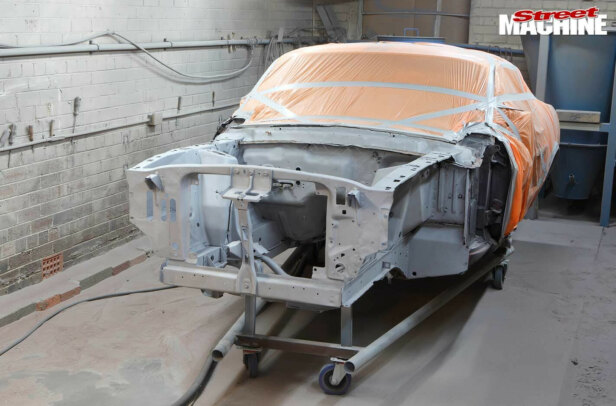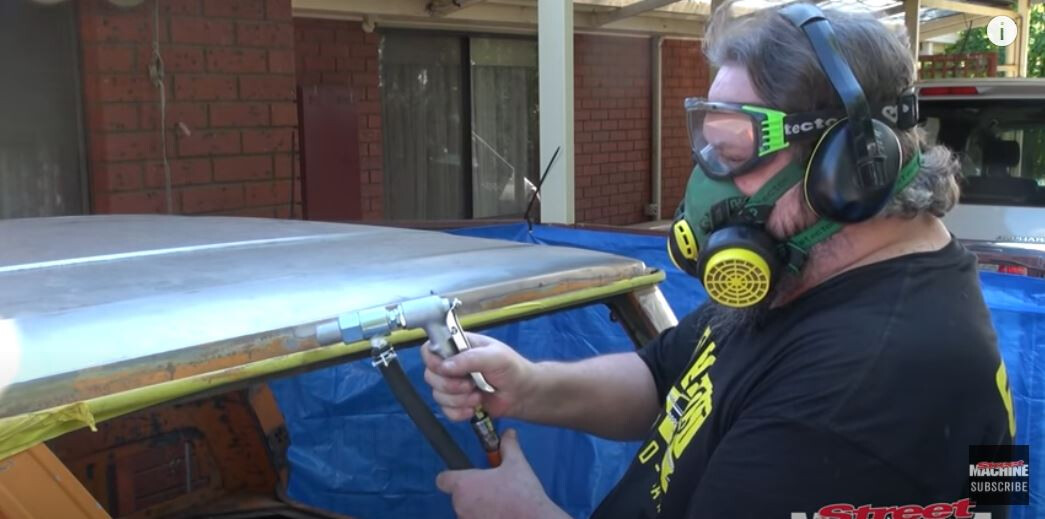The only way to know what lies beneath your streeter’s paint is to strip it all off, a process that can be a total pain in the backside. Traditional options include sanding, chemical stripping, sand-blasting or bead-blasting. But there’s another option: soda-blasting. Instead of using grains of sand or small glass beads, this method uses compressed air to blast the surface with fine granules of bicarbonate of soda. Sodium bicarbonate, baking soda, call it what you will, it’s the same stuff your mum uses to bake cakes!
First published in the March 2007 issue of Street Machine
Soda-blasting offers two major advantages over sand or bead-blasting: it’s far gentler and it’s water soluble. Although the process has been around for a while, early attempts at it here in Australia gave lacklustre results.

“They were using the wrong machinery,” reckon John Crabtree and Adam Thew of Sodablast Australia. “We knew it worked, so we went to the States, learnt about it and imported the correct machinery.”
To prove their point, the guys invited Street Machine around for a demonstration.
Although you’d normally disassemble the car before blasting, the crew from Sodablast decided to use this fully-assembled ’66 VC Valiant to demonstrate the effect that soda has on various materials and surfaces like rubber, glass, chrome, stainless steel, grease, proof-coat, aluminium, body filler and, of course, paint!
Step-by-step:
Step 1

This is the stuff: bio-degradable, food-grade bicarbonate of soda, or just plain baking soda. It’s available in different granule sizes; a larger granule size than ya mum uses for baking cakes has proved best for blasting.
The spent media is non-toxic but also non-reusable so it’s simply collected and disposed of per EPA requirements.
Step 2

This specialised nozzle was specifically designed for soda-blasting. The peripheral holes are for introducing water to quell dust when blasting out in the open and for certain cleaning procedures.
The aggressiveness and cutting action are varied by altering the air pressure and volume of media. Both can be adjusted by the operator on the go.
Step 3

The compressed air pushing the soda through the line must be cool and ultra-dry, otherwise it clogs up the line and nozzle.
When air goes through a compressor it gets hot, which increases condensation. For this reason the blasting unit is fitted with very high-quality moisture separators as well as a cooler.
Step 4

Operators wear a paper suit (the same style as commonly worn by spray painters) along with a positive-pressure helmet into which purified air is pumped.
Although soda is non-toxic, the helmet and suit stop the operator breathing the dust in, and prevent it from filling their every crack and crevice.
Step 5

To contain the dust, Sodablast has built a special blast booth. Most of the heavy particles fall straight to floor but a lot of dust is created.
To manage this, a large fan at one end pushes fresh air in, while a huge exhaust fan at the other draws out and captures the airborne dust. Dust extraction is also necessary to improve vision within the booth.
Step 6

The stripping mechanism of soda-blasting is quite different to other abrasives. The soda granules are particularly brittle and fracture on impact with the surface.
It’s this fracturing action that actually does the work of displacing the paint, not the granules themselves smashing into the surface at high velocity. Hence its gentleness.
Step 7

Look carefully and you can clearly see how the blasting has stripped away each of the layers one by one, down to the protective coating on the steel.
It’s controllable enough that you can leave the gel-coat untouched when stripping fibreglass. The Sodablast guys have even been able to leave behind the manufacturer’s original pen marks!
Step 8


Bicarbonate of soda plus water and grease makes soap, which makes soda-blasting excellent for cleaning dirty, oily or greasy objects. It’s also ‘friable’ — it completely crushes down to dust.
This means it doesn’t grit up and destroy any bearing areas it happens to work its way into, which can be a huge problem with sand or bead-blasting.
Step 9

Being far more gentle than sand-blasting, a lot of delicate components like diecast carburettor bodies, brake calipers and other alloy components can be soda-blasted.
Used correctly, it leaves machined surfaces untouched, which is ideal for cleaning things like cylinder heads as it doesn’t gouge into any of the precision-machined surfaces.
Step 10

The soda granules are much finer than the media used in sand-blasting or bead-blasting. This, combined with the fracturing process, allows soda-blasting to get into areas of extremely fine detail.
With cars, this is especially important at getting right into complex join areas — as seen here around the Valiant’s headlight recess.
Step 11

Low pressure leaves delicate surfaces undamaged, yet it’s still able to make chrome all bright and sparkly. Note how the indicator lens looks untouched.
Soda-blasting does not generate any sparks, making it safe for cleaning fuel tanks and other fuel-related items. It also deodorises as it goes, eradicating musky, oily or smoky odours.
Step 12

Blasting leaves behind a fine surface coating that dramatically inhibits the onset of corrosion. Once stripped, your car (or other ferrous metal object) can be left in bare metal for quite some time.
When dry, you can touch the bare metal without inducing surface corrosion.
BLAST AWAY



This sequence of shots shows how the pressure can be dialled down to leave plastic body-filler basically untouched. To carve into the filler, the pressure is upped and the soda shot is concentrated. The fine granule-size and fracturing action allows soda-blasting to eat right into the bottom of rust pits without beating the heck out of the good metal around it, so there’s no panel warpage.
Due to its softer nature, soda-blasting is a bit slower than sand or bead-blasting. However, stripping a whole car is still only a one-day proposition as Sodablast uses multiple operators to speed up proceedings.
WRAP UP
No panel damage and no sand or glass beads leaking out of cavities for the next decade. Being water soluble, a thorough wash is all that’s needed to remove any leftover soda. Hot water is more effective at dissolving soda and is the preferred option. Soda-blasting doesn’t like soft surfaces — it pretty much bounces straight off because it’s not hard enough to fracture the granules.

The advantage is that you can do the underside of your car without disassembling everything as it won’t gouge into rubber brake hoses or fuel lines. It also leaves the thin zinc plating on factory hard lines. In fact you could drive your car to be stripped and then drive it home!



Comments